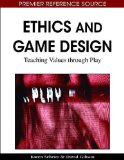I’m proud to announce that the book to which I’d contributed a chapter, Ethics and Game Design: Teaching Values Through Play is finally published! My co-author Scott Seider and I contributed the chapter, “Video Games for Prosocial Learning,” a broad overview of how video games fit in the tradition of prosocial education. (I guess it was so broad that the chapter was thrown into the “Situating Ethics and Games” intro section to the book).

I’m excited, too, that several of my colleagues from Harvard/MIT back when we were writing this chapter are also in featured — Jaroslav Švelch and Sam Gilbert. I’m looking forward to reading their contributions. And I really want to thank our ringleader, Karen Schrier, for bringing this eclectic group of scholars (and, in my case, pseudo-scholars) to put the whole project together.
Of course I hope people will get the word out about the book, and that libraries will go and buy it, but if you’re not interested in shelling out $132, I’m making available an earlier draft of our submitted chapter here:
Download Video Games for Prosocial Learning by Gene Koo and Scott Seider.
Abstract: In this chapter, we consider the capabilities video games offer to educators who seek to foster prosocial development using three popular frameworks: moral education, character education, and care ethics. While all three of these frameworks previously considered literature and film as helpful tools, we suggest that video games are unique from these other media in the multiple levers through which they can influence the worldview, values, and behaviors of players. Similar to literature and film, video games possess content — plot, characters, conflict, themes, and imagery — with which participants interact. Unlike other media, however, video games scaffold players’ experiences not only via narrative and audio-visual content but by the rules, principles, and objectives governing what participants do. Moreover, many video games possess an ecosystem that impacts players’ interpretation of the game itself — for example, on-line hint guides and discussion groups as well as the opportunity to play in the company of peers in either physical or virtual proximity. We consider opportunities and challenges presented by each of these unique facets of video games for fostering the prosocial development of participants.
Would love any feedback on this chapter, on the book, or on the entire concept of games and ethical learning!